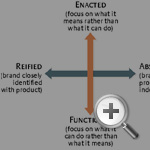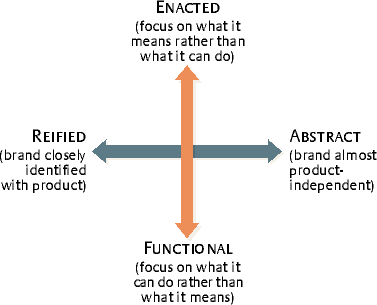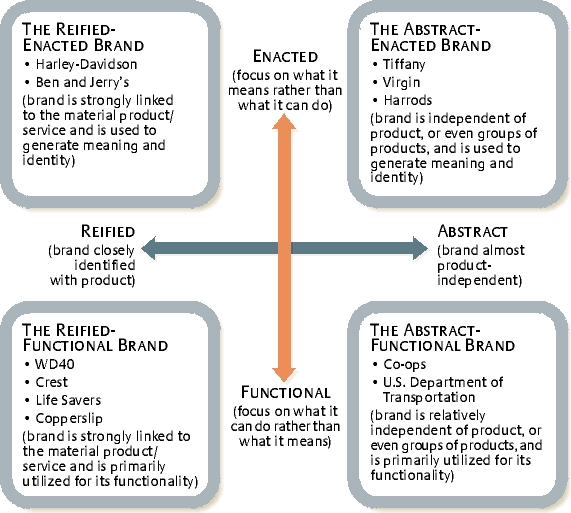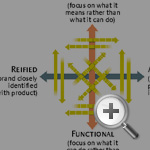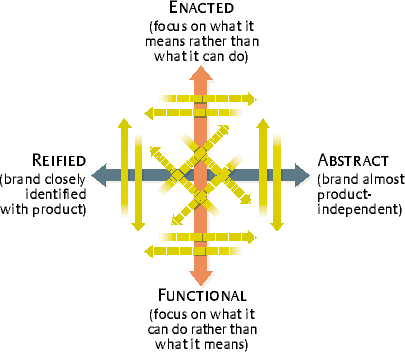Understanding and Managing the Brand Space
Topics
Many companies have made costly mistakes in managing their brands. Arthur Andersen, Martha Stewart Living Omnimedia, Ford Motor Co. and Firestone are but some of the more infamous examples. Less dramatically, many firms have faltered badly in their attempts to extend their brands by moving them into different product categories, resulting in damage to the parent brands.1 The root cause of these kinds of missteps is, at least in part, the lack of a fundamental understanding of brands and their changing nature.
Part of the problem is that brands have become increasingly difficult to manage. As they have become more global, for instance, they have come to characterize more than merely the relationship between manufacturers and customers. Their influence now extends to employees, the investment community, the media, suppliers, governments and even competitors. The meaning of a brand is no longer the result of a dialogue between buyer and seller, but of a multilogue. A company that wishes to extend its brand must therefore negotiate that transition among all the various parties involved. This process has become even more difficult because the widespread availability of information over the Internet and other media has weakened the influence that marketers have over their own brands.
To manage their brands effectively, companies must not only take a much more customer-centric view,2 they must also have the appropriate tools. To that end, we have developed a theoretical framework based on our proposed concept of a brand space. Two dimensions define the brand space: the degree of abstraction (whether the brand has become independent from its associated product) and the degree of enactment (whether the brand focuses more on the meaning of a product or its functionality). Companies that understand where their brands are in that space, and where they need them to be, will be more successful brand managers in an environment of escalating competition and rapidly changing markets.
Companies have traditionally taken a minimalist view of brands as an effective means of identifying and differentiating their products and services.3 In contrast, we favor the broader view of a brand as a symbol around which a relationship and experiences can evolve.4 Such a symbol both mediates and embodies — rather than merely denoting — the buyer-seller relationship. As such, brands carry connotations and associations that are rich with meanings to customers, company managers and employees, and others. They have a life and meaning beyond — and, to some extent, independent of — that intended by their initiators.
A high-level approach to conceptualizing brands can be developed on the basis of the three-worlds hypothesis of Karl R. Popper, which distinguishes between three different realms: physical objects, subjective experience and culture.5 Using that work as a foundation, we propose the dimensions of abstraction and enactment, which we believe provide a broad and useful perspective on the novel developments taking place in branding today. We define abstraction as the process of moving from the physical, tangible or concrete to the realm of thoughts, ideas or feelings. The term enactment is drawn from the social psychology literature and refers to the process by which individuals create their environments.6 Here, we employ the term to denote the purposeful act of creating or making, rather than the passive process of sensing or receiving. An enacted brand, then, is one for which consumers themselves help construct the customer-brand relationship and experience.
Abstraction
Originally, brands functioned at a very low level of abstraction. They were simply signifiers of specific products and manufacturers. Over time, however, many manufacturers have attempted to stretch or extend their brands, initially through the introduction of variations (color, flavor or size, for example) within the same product category but later seeking to encompass new categories under the same brand umbrella (Honda’s move from motorbikes to automobiles, for example). The arguments in support of that approach were originally driven by the rising costs of establishing new brands.7 But after many brand extensions failed and companies became aware of the approach’s full risks and potential costs,8 enthusiasm for them waned.9
Among manufacturers, brands have tended to be product-oriented, partly because such corporations typically have organizational structures that are product-focused. Johnson & Johnson, for instance, has nearly 200 operating companies for its numerous product brands: Band-Aid, Acuvue, Tylenol, Mylanta, Stayfree and so on. Nevertheless, some brands have clearly made the jump to become product themes. A few have even become virtually product-independent, tending rather to embody an idea, concept or image, and functioning at a high level of abstraction.
The Virgin brand provides an example of a progression along this spectrum. Originally tied to the production of rock music recordings, the brand soon encompassed record shops selling a wide range of popular music products. As the level of abstraction grew, the Virgin brand became entirely uncoupled from its original product-category origins. Indeed, the company recently sold its record business and branched out into Internet services, financial services, mobile-phone services and other businesses. However, although the Virgin brand has become independent from its product-category origins, it still articulates the abstracted characteristics of those origins —namely, fun, hip and subversive. Virgin Atlantic, for example, has challenged the status quo of British Airways and other trans-Atlantic carriers, and Virgin Cola has taken on the well-entrenched Coca-Cola and Pepsi.
Other brands have progressed along this continuum of abstraction yet remain primarily product-related. For example, Land Rover has successfully broadened the line of products covered by its brand through its thematic accessories program. First launched in the United Kingdom and recently expanded into the United States, the program introduced a line of products including rugged outdoor clothes, shoes, car accessories and mountain bikes. In effect, Land Rover moved its brand along the abstract dimension from a specific product to a group of them — while keeping the brand anchored by its core product. U.S. brewing and tobacco industries have used a similar strategy, as witnessed by Miller’s Plank Road Brewery (Miller-owned brewers) and R.J. Reynolds’ Moonlight Tobacco Co. (innovative tobacco branding for the style conscious).10
Enactment
The second dimension, enactment, deals with functional performance: What a product can do versus what the brand means to consumers or buyers. At the low-enactment extreme, a brand can be very strongly linked to purely functional considerations. WD-40, the mechanical lubricant, is a case in point. At the high-enactment extreme, brands can be minimally tied to function but nonetheless carry tremendous meaning for the consumer. Designer brands, such as Ralph Lauren or Calvin Klein, and retail brands, like Harrods or Neiman Marcus, fall into that category.
Our distinction between function and enactment is related to the work of several other researchers, and we agree with those who contend that brand concepts may in some cases offer both functionality and enactment.11 In such cases, we focus primarily on the relative importance between the two.12
Understanding the Brand Space
Together the dimensions of abstraction and enactment form a two-dimensional matrix called a brand space. (See “The Brand Space.”) All brands may exhibit different shades of meaning in different contexts; however, some cautious generalizations can be made when discussing relatively homogeneous groups of consumers. There are four archetypal positions in the space:
The Reified-Functional Brand
This low-abstraction, function-focused position is the typical starting point for a brand manager at a packaged-goods manufacturer, and the rules of this game are generally believed to be well understood. Nevertheless, many companies have made costly mistakes in managing such brands, and as a result a number of them have been busy repairing the subsequent damage.13 Procter & Gamble, for instance, has reportedly adopted the marketing mantra of “Make It Simple” in an effort to reduce confusion among its customers. A few years ago, a Business Week article on P&G asked the pointed questions,“Does the world really need 31 varieties of Head & Shoulders shampoo? Or 52 versions of Crest?”14
The advantage of a reified-functional position is that, because the brand is closely tied to a product, marketers have a relatively high degree of control. They can change a brand by altering some of the characteristics of the product, such as its quality, design, packaging and so on. Nonetheless, there are disadvantages. For example, one attribute of brands is that they have traditionally reduced a consumer’s search costs, but today that function can be performed by Web-based recommendation systems such as Epinions. Thus, a highly functional brand is more susceptible to substitution by alternative products.15
The Reified-Enacted Brand
This is the position that a fortunate few product manufacturers such as Harley-Davidson, Jaguar, Ferrari and Rolex have attained and that many others envy. The marketer still retains a relatively high degree of control, but because the brand is enacted, it can command a premium price, over and above its functional worth.
The Abstract-Functional Brand
Increasing numbers of packaged-goods companies have tried to attain this position. They wish to move beyond reified brands and extend them to new categories of products. But, as mentioned earlier, many of those leveraging attempts have failed, leading companies to rethink their strategies. Subsequently, one approach that has gained favor is the use of an encompassing brand architecture that describes an explicit set of relationships within a family of products. For example, most consumers recognize the Walkman and Discman as the offspring of the parent brand Sony. The architecture helps minimize confusion among the subbrands in a market. By understanding and capitalizing on such associations, companies can attain a significantly higher batting average on brand extensions than has traditionally been the case.
The functional aspect of an abstract-functional brand provides companies with some degree of control over the brand. However, the logistics are more complex than in the reified case. Because the brand is abstracted over a number of product categories, poor quality in one product class can easily taint the reputations of other offerings under the brand’s umbrella. For example, the spillover effect of the problems with the Ford Explorer SUV is likely to have affected consumers’ perception of Ford and its subbrands.
The Abstract-Enacted Brand
This position might appear to offer companies the greatest flexibility, but abstract-enacted brands have their own drawbacks because consumers feel greater “ownership.” There is perhaps no better illustration of the hazards posed by such a position than the experience of Coca-Cola when it tried to launch “new Coke.” “Don’t mess with our Coke” became the universal battle cry of outraged loyal consumers, who eventually forced the company to back down in a clear demonstration of proprietorship.
Despite such difficulties, the world’s most valuable brands will likely continue to occupy this quadrant of the brand space. That said, companies that manage these brands — such as IBM, Disney and Sony — must continue to nurture them with great delicacy, remaining always sensitive and responsive to consumer concerns. The same is true for brands aspiring to the abstract-enacted position. For example, Harley-Davidson has a fairly extensive licensing program, offering the manufacturers and sellers of noncompeting products (clothing, accoutrements and even cafés) the opportunity to utilize the Harley brand name. If successful, that maneuver would move Harley from the reified-enacted classification into the abstract-enacted category. At the same time, it would greatly complicate the company’s brand management because of the wide range of offerings.
Each quadrant of the brand space is occupied by many of today’s well-known brands. (See “Archetypal Brand Positions.”) As noted earlier, however, the positions of those brands could —and probably will — change in the future.
Managing the Dynamics of the Brand Space
Brands take their embodied meanings from a dialogue among customers and various other stakeholders. Because language and meaning are continuously evolving, what a brand signifies can change over time. That has two important implications. First, the meaning of a brand can never be static. Second, a brand is never unilaterally created; it always arises from the interactions of stakeholders in a wide community with certain linguistic and cultural characteristics. Consequently, companies cannot so much manage a stable brand image as negotiate an evolving one. Moreover, the negotiation must involve the relevant internal and external stakeholders. Stakeholders’ perceptions of a brand arise from information they receive about it from the company, other customers and third parties (brand communications) and from direct interactions they have with it (brand embodiments) — including myriad interactions among the product, consumers, employees, suppliers, intermediaries and other third parties. Some of these factors are directly under an organization’s control (internal), whereas others are not (external).
Negotiating the meaning of a brand has become more complex because contemporary marketers have a variety of constituents. Brands have become more visible internationally, and their role has expanded far beyond the interface between company and customer, encompassing other parties such as the investment community, governments, suppliers and employees around the world. All these stakeholders have differing motives and interests that vastly complicate brand management.
For every brand there is an existing pattern of associations that constitutes its heritage. Any company trying to evolve its brand must ensure that it retains some of that heritage or else risk losing its existing customer base. The company has to find ways to interpret the brand’s future in terms of its past or reinterpret its past in terms of its future. Consider the brilliant marketing maneuver of Guinness. When the company wanted to broaden its appeal to reach younger international consumers, it did so by evoking the brand’s rich legacy. Specifically, Guinness helped set up more than 2,000 drinking establishments around the world, all replicating the Irish pub experience.
Volvo’s recent repositioning is another case in point. Traditionally, the Volvo brand was associated with safety, but during the 1990s the company placed a greater emphasis on sportiness and attractive appearance. It did so, however, by building on the brand’s traditional heritage, designing cars that combined speed and elegance with safety. This raises an important point. As additional associations are created with a brand, the brand necessarily becomes more abstract.
Trying to migrate a brand from reified-functional to higher levels of abstraction may not be the easiest way for companies to minimize the entry costs of future brand extensions and leveraging. British retailers such as Tesco and Sainsbury’s have employed a different strategy, investing considerably in developing their corporate brands, which have enabled them to more easily expand the range of products they sell from food items to consumer electronics and financial services.
Another reason for the growing potency of abstract brands is the 21st century consumer’s shrinking bandwidth. Today’s consumers are incomparably rich in the numbers and types of products available to them, but that abundance places limitations on the number of additional branding associations they can store and access in their long-term memories. Abstract brands help to streamline the number of brand associations that people must process.
After a brand has been established, its managers may wish to move it across the brand space along one of the migration paths. (See “Dynamics of the Brand Space.”) Choices among the alternatives depend greatly on managers’ objectives and strategies. Nonetheless, a few generalizations are in order. First, any repositioning must be considered very carefully because of the risk of alienating core users and the difficulty of altering positions in consumers’ minds. The days when a new brand manager felt free to change a marketing campaign or ad agency at whim are long gone. Second, movement along a single dimension is usually much easier to accomplish than diagonal moves, which are more complex and likely to confuse customers, not to mention sales-people and intermediaries. Third, reifying an abstract brand or functionalizing an enacted one is much easier than the reverse.
Consider Jell-O, which appears to be descending in the brand space. In the past, Jell-O could have been considered a reified-enacted brand, but today it may be moving toward becoming a reified-functional brand, as Kraft Foods repositions it away from the concept of “family fun” and toward the more health-conscious message of “no fat, no cholesterol.” Jell-O’s example shows how a brand’s link with a physical product can remain strong while the consumer’s level of enactment changes.
Often societal changes cause brands to move in the brand space. For the housebound female of the 1950s who had few career prospects, keeping house carried a very different connotation than it does for either adult member of a busy two-earner household in the 21st century. Thus, the brands of many household products that previously played an important role in consumers’ lives, whether they were detergents, shoe polishes or instant coffee, are becoming solely functional brands, rather than retaining the enacted aspects that their promoters might prefer. Examples here include such brands as Kiwi Shoe Polish, Clorox and Tide.
Demographic changes are another factor. Such familiar brands as Old Spice, Cadillac, Guinness and Club Med have all faced the aging demographics of their customers with mixed results. Perhaps one of the most dramatic changes is exemplified by the Web site oldspice.com, which Procter & Gamble established after it acquired the brand. In a clear attempt to reach a much younger audience, the Web site invites visitors to “spice it up” with Red Zone. Similarly, such traditional beacons of retail success as Marks & Spencer, Sears, Dillard’s and Kmart have faced comparable challenges as the expectations, aspirations and affluence of their core markets have changed. The introduction of Sears Brand Central was in response to the growing affluence and sophistication of the company’s customers in Middle America, who were increasingly seeking designer labels such as Pierre Cardin, Seiko, Cuisinart and Vidal Sassoon instead of the safe and familiar Sears brand.
Technology has also had an impact. Specifically, the Internet, search engines and intelligent software agents have given consumers alternative ways to access the kind of information traditionally provided by brands.16 A prospective buyer of a name-brand product can now use the Web to find a comparable item that is cheaper. That ability of sophisticated customers to trade down in this way is far greater for brands located in the lower left quadrant of the brand space. But when brands become enacted and abstract, they are much more likely to weather the effects of the Web-based information explosion that enables consumers to access multiple sources of data about products.17
But enacted and abstract brands face a different problem. As brand meanings and associations increasingly become the products of an ongoing multilogue among consumers, employees, the media, suppliers, competitors and other parties, they are moving beyond the sole control of the marketers. The more enacted and abstract the brand, the more pronounced the phenomenon. Thus, the ability of marketers to control the meaning of brands that have successfully become enacted and abstract is limited —a paradox with a pleasing if somewhat perverse symmetry in that the reward for success is the diminished control over the “property” that has been created. Perhaps that is why many managers now approach brand repositioning with great trepidation.
Brands in the 21st Century
Certainly, to derive commercial benefit from attempts at mass customization, a company must integrate a sophisticated understanding of its customers with its operations and overall way of doing business. As that goal of achieving consumer insight and intimacy has eluded traditional approaches, companies have begun to focus on the wider realm of consumption experiences18 and have turned increasingly to ethnographic and other qualitative research to get a better sense of the complete lives of their consumers.
Traditional market research may become even less useful as customer-brand relationships and consumer-constructed brand meanings become more inscrutable. Companies that want to make their brands more enacted will face a difficult dilemma: Although an organization is much more likely to attain competitive advantages from highly enacted brands, such brands also require much greater effort and resources — for one thing, a deeper understanding on the part of marketers — than do functional brands.
The concept of brand spaces can help companies understand and manage their brands more effectively in a number of ways, providing a framework, for instance, within which to consider the potential impact of brand extensions. Specifically, as brands move to the upper right quadrant of the brand space, they can encompass an inclusive set of products and services, but that transition means that multiple stakeholders will then link additional meanings and associations to the brand. Managers must therefore attain a sophisticated understanding of their brands in order to extend them successfully without damaging them in the process.
Similarly, when companies are faced with adverse events, whether initiated by competitors or by other external factors, they could consider repositioning their brands in the space. Sometimes, for instance, a company facing a crisis might be wise to emphasize the heritage of its brand, even if that means moving from an abstract to a reified position in the brand space. Ford and Firestone might have mitigated some of the damage suffered by their brands during the crises involving tires on the Explorer had they implemented such a defensive maneuver. Whether Martha Stewart Living Omnimedia will adopt that strategy to distance itself from its beleaguered founder remains to be seen, but the company has reportedly been developing a new magazine called Everyday Food — its first publication without her name in the title.
Indeed, marketing in the 21st century will take place in a world where so many of the rules have changed that traditional approaches may prove limited at best and, quite possibly, downright misleading. In such an environment, brand management will become an increasingly complex and difficult undertaking.
References
1. V. Swaminathan, R.J. Fox and S.K. Reddy, “The Impact of Brand Extension Introduction on Choice,” Journal of Marketing 65, no. 4 (2001): 1–15.
2. N. Capon, P.R. Berthon, J.M. Hulbert and L.F. Pitt, “Brand Custodian: The New Role of Senior Management,” European Management Journal 19, no. 3 (2001): 215–227.
3. T. Ambler, “Do Brands Benefit Consumers?” International Journal of Advertising 16 (1997): 167–198; and P. Kotler, “Marketing Management” (Englewood Cliffs, New Jersey: Prentice-Hall, 1996).
4. P.R. Berthon, J.M Hulbert and L.F. Pitt, “Brand Management Prognostications,” Sloan Management Review (winter 1999): 53–65.
5. K.R. Popper, “Knowledge and the Body-Mind Problem: In Defense of Interaction,” ed. M.A. Nottumo (London: Routledge, 1994).
6. K.E. Weick, “The Social Psychology of Organizing” (Reading, Massachusetts: Addison Wesley, 1979).
7. E. Tauber, “Brand Leveraging: Strategies for Growth in a Cost-Control World,” Journal of Advertising Research 28 (August–September 1988): 26–30; and D.A. Aaker, “Managing Brand Equity: Capitalizing on the Value of the Brand Name” (New York: Free Press, 1996).
8. S.K. Reddy, S.L. Holak and S. Bhat, “To Extend or Not To Extend: Success Determinants of Line Extensions,” Journal of Marketing Research 31 (May 1994): 243–262.
9. “Software’s Holy Grail: No-Fuss Clicking Is What Consumers Need Most,” Business Week, June 24, 1996, 50–53.
10. R. Tomkins, “The Giant Who Lurks Behind a Smokescreen,” Financial Times, Feb. 3, 1997, 14.
11. J.A. Howard and J. Sheth, “The Theory of Buyer Behavior” (New York: John Wiley & Sons, 1969); M.B. Holbrook and E.C. Hirschman, “The Experiential Aspects of Consumption: Consumer Fantasies, Feelings and Fun,” Journal of Consumer Research 9 (September 1982): 132–140; and A. Chaudhuri and M.B. Holbrook, “The Chain of Effects From Brand Trust and Brand Affect to Brand Performance: The Role of Brand Loyalty,” Journal of Marketing 65 (April 2001): 81–93.
12. M. Addis and M.B. Holbrook, “On the Conceptual Link Between Mass Customisation and Experiential Consumption: An Explosion of Subjectivity,” Journal of Consumer Behaviour 1 (June 2001): 50–66.
13. Berthon, “Brand Management” (winter 1999).
14. “Make It Simple. That’s P&G’s New Marketing Mantra — And It’s Spreading,” Business Week, Sept. 9, 1996, 56–61.
15. Berthon, “Brand Management” (winter 1999).
16. P.R. Berthon, L.F. Pitt and R.T. Watson, “The World Wide Web as an Advertising Medium: Towards an Understanding of Conversion Efficiency,” Journal of Advertising Research 36 (January–February 1996): 43–53; and Berthon, “Brand Management” (winter 1999).
17. P.R. Berthon, J.M Hulbert and M.B. Holbrook, “Beyond Market Orientation: A Conceptualization of Market Evolution,” Journal of Interactive Marketing 14 (summer 2000): 50–66.
18. M.B. Holbrook and E.C. Hirschman, “The Experiential Aspects of Consumption: Consumer Fantasies, Feelings and Fun,” Journal of Consumer Research 9 (September 1982): 132–140; J.B. Pine II and J.H. Gilmore, “The Experience Economy: Work Is Theatre and Every Business a Stage” (Boston: Harvard Business School Publishing, 1999); and B. Schmitt, “Experiential Marketing: How To Get Customers to Sense, Feel, Think, Act, and Relate to Your Company and Brands” (New York: Free Press, 1999).



